Totally Unnamed Gaming Column - We are what wii ware.
by dw,
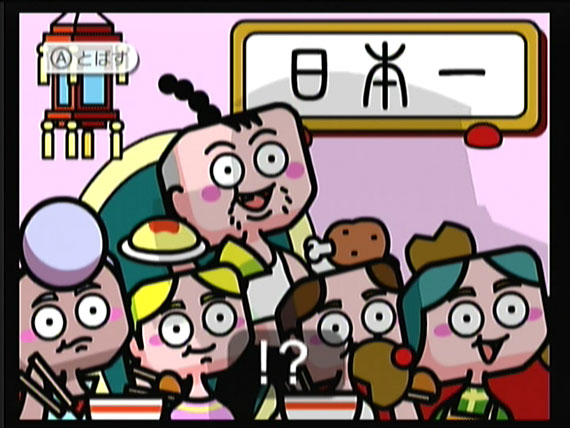
|
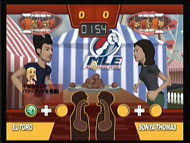
|
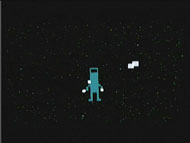
|
|
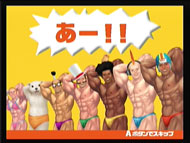
|
|
 | |
The one major difference between the current generation of consoles and the previous is the prevalence of online gaming and downloadable content. Sure the original Xbox had both, but it wasn't until this generation that its competition did as well. Xbox Live, Playstation Network and the Wii Shopping Channel have much in common, they all have a wide selection of retro games, they're all overcomplicated and they all use the money/points in the bucket system.
Instead of being able to pay the exact amount of money for a game like you would in a retail store, you instead have to purchase a preset amount of credit that's almost always slightly more than the game is. This means that after the transaction is complete you're left with a few cents or points in credit which aren't enough for you to purchase anything else. So you're left with the choice of either having wasted your money by not being able spend the remaining points or caving in and topping up your points to be able to get something decent. Either way, the companies win.
What's more is that some game developers will let you pay big money for absolutely nothing in return. It seems the days of getting cheats and cheat codes for free is waning, on the 360 you're able purchase cheats and upgrades to help you out in certain games (Mostly EA titles...) like unlocking cars in racing games that are usually not available at the beginning of the game so you can easily win races. In some other titles, including Soul Calibur IV, you have to pay to be able to play as Yoda/Vader (depending on which console) even though the characters themselves ARE ON THE DISK.
But amongst the ripoffs there are a few gems and some of them aren't even games. What I've noticed, especially on the Wii, is the rise in the number of software titles you're able to get. Most of it coming from Japan, which I think because they've released that consoles can do other things besides play games and watch movies. Take JOYSOUND for instance, it's a Karaoke software for the Wii, not Karaoke game, but Karaoke software. While it comes with a meager amount of songs on the disk (none on the wiiware version), the online catalogue it has is enormous and while you may have to rent the songs, they're much cheaper than the Rock Band/Guitar Hero/Singstar songs and it's way for hikikomori's to be able to do Karaoke.
And speaking of Wiiware, let's step over my terrible segue and take a look at some.
[DW] Wii: Major League Eating: The Game (Mastiff)

|
|

|

|
| Probable Rating | G |
| Release Date | 14/07/2008 |
| # of Players | 1-2 (Local or Online) |
| Availability | Wiiware: US and JP only |
| Language | English/Japanese |
| Fluency/Literacy Level | Basic |
If your like me and I know I am, something you might have come across while perusing cable television is professional eating contests. While such competitions aren't new, the commercialization and regulation of the "sport" is. It even has it's own legends of eating, one such legendary eater is Takeru "The Tsunami" Kobayashi who held the record for eating the most hot-dogs in 12 minutes (the standard eating competition time limit), though he later lost in a hot-dog eating contest against a bear.
Not only does Major League Eating: The Down feature Kobayashi and other famous professional eaters, it also features the bear in question! You start off as one of the game's original characters, each of whom has a speciality food, to fight against the professional eaters in a Mortal Kombat style ladder. The rules for each match are simple: eat more food than your opponent in the specified time limit.
The gameplay consists of flicking the wiimote upwards to throw/place food in your mouth then chewing the food by pressing the B button as the teeth meter passes over the food in your mouth. Though while this sounds simple, your fighting the motion control most of the time. When I lifted the wiimote upwards, most of the time it wouldn't register and the rest of the time it was hard to see the distinction in the motions between placing the food in your mouth (the optimum method) and hurling it up in the air and catching it in your mouth (which was much slower).
Chewing the food also puts up a fight because there's a slight lag between where you think the meter is and where the meter registers. So most of the time you go to bite down and instead bite your tongue or cheeks, which causes you not to be able to chew for a brief moment. But the thing is, you're not told when you're able to chew again so you find yourself accidentally chewing your lip again once as soon as penalty is over and going into another penalty.
Every so often the pieces of food you pick up will contain power-ups which mess with your opponent. These allow you to do things like burp and the opponent to upset their stomach or be something like a chilli pepper which will stop them from doing anything for a short while. Though you have to be careful as your opponent is able to use power-ups against you and if you don't keep your stomach gauge down you'll find yourself throwing up and losing the match instantly.
Overall the game leaves a lot to be desired, with it's poor graphics and terrible gameplay it really isn't worth getting. It's only available on the US and JP WiiWare stores so you'll either need a US or JP Wii to be able to torture yourself with it. Though I'm glad that I least got on the JP store for 500 points, because the US store is double that...
[DW] Wii:Bit. Trip Beat (Gaijin Games)

|
|

|

|
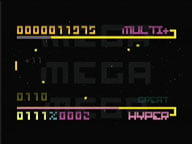
|
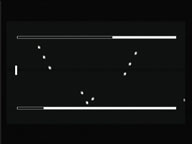
|
| Probable Rating | G |
| Release Date | 16/03/2009 |
| # of Players | 1-4 (Local) |
| Availability | Wiiware: US, JP and PAL |
| Language | English |
| Fluency/Literacy Level | Basic |
Did you ever think to yourself "I like Pong, but it would be so much better as a Rhythm Game!"? No? Neither did I, so it pretty much blew my mind when I heard the concept behind Bit. Trip Beat. Basically the game plays quite similar to Pong, move your paddle up and down to hit blocks, but each block comes at you in time to the music and when you hit them, they generate notes in the song.
But they aren't just your standard pong blocks either, some of them freeze midway down the screen, move sideways and then proceed on their way. Others will boomerang back towards you and you have to hit them a couple of times before they go on their way. Occasionally a bonus/challenge block will come into the mix. The bonuses can either give you a longer paddle* or multiple paddles which are usually required to complete an upcoming sequences of notes successfully. The challenges make the game harder by making your paddle much smaller and if you're able to hit enough blocks during the challenge you're awarded bonus points.
At the end of each level you fight off against a boss. The fight consists of the boss firing pieces of itself at you, with the boss being defeated when it's out of blocks.
During each level there is actually 3 different levels of gameplay. You start off in Hyper Mode, where everything is mostly normal. Every block hit adds to your Mega bar and every block missed adds to your Nether bar. When your Mega bar is full you go into Mega mode and you're rewarded with a more detailed version of the song you're playing through. But if you miss too many blocks you go into Nether mode, where the picture is monotone and the sound is too, but it only comes out of the wiimote's speaker. In Mega mode, what was the Mega bar is now the Multi+ bar and each time you fill it up your score multiplier is raised. Though if you miss too many blocks in Mega mode, you're dropped back into Hyper mode and if you miss too many in Nether mode it's game over.
The game is quite challenging, but if you can work out the patterns of certain sets of blocks you should be okay. And because the songs play exactly the same each time through you can always practice them until you get the hang of it. Occasionally the events happening in background which detail your character's journey through space can distract you from the gameplay, especially meteors which happen to be the same colour as most of the blocks... Mega mode can feel like synesthesia sometimes, with blur of colours and noise leaving you confused, usually resulting in a quick trip back into Hyper mode.
While there's no multiplayer mode listed in the menu, if you have more than one Wiimote turned on other people can help you play the level, but as you add in more players the paddles become smaller to keep the relative difficulty per player the same.
I'd recommend any arcade/rhythm fan to give it a go since it's well worth the 500-600 points to buy it. It's available on all the WiiWare stores.
*If your paddle remains long for more than 4 hours consult a doctor.
[DW] Wii: Let's Zenryoku Hitchhike (Nippon Ichi Software)

|
|

|
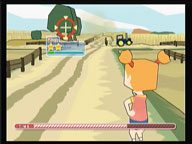
|
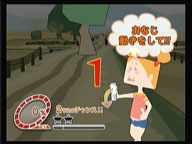
|
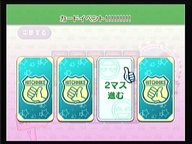
|
| Probable Rating | G |
| Release Date | 31/03/2009 |
| # of Players | 1-4 (Local) |
| Availability | Wiiware: JP only (Possible US Release Soon) |
| Language | Japanese |
| Fluency/Literacy Level | Basic: Hiragana/Katakana |
Your family is on holiday and enjoying a nice meal at a restaurant, suddenly you're under attack from dinosaurs and UFOs. What are you going to do? Runaway, of course! Your only choice is to Hitchhike your way home, taking advantage of any helpful car, tractor, cow or tree. But, what's this? Because you skipped out on paying your meal the restaurant owner has snapped and is chasing after you in order to make you PAY!
One thing I have to give Let's Zenryoku Hitchhike is that it has a pretty outrageous plot. The premise of the game is to hitchhike across various environs while trying to avoid being caught by the now homicidal restaurateur. Each level is essentially a board game, with each character taking turns at hitchhiking in order to move their character to the goal.
When it's your turn you get taken down to street level where you have to use the Wiimote to point at which form of transportation you're going to attempt to flag down. You can attempt to hitch a lift from varying region specific entities travelling on the road, with each having a different star value. The star value indicates how many places you'll be able to move your character if you can successfully flag them down. But also, the higher the star value the more difficult it will be.
During certain turns you'll be able to flag down things in the background, like trees or the sun. But sometimes there will be things you can't actually hitch a lift from and you've essentially wasted your turn. Also you lose the ability to target certain rides if they've gone halfway across the screen.
As soon as you flag down a transport it will divert towards you and you will be shown the movement you need to replicate on the Wiimote in order successfully flag it down. The number of stars determines the number of sections in the gauge. As you replicate the moves you're given a percentage based on how accurate you are. The percentage you get fills up the gauge and indicates how many moves you'll be able to make. So while you may flag down a 4 star sports car, if you only get 1 star you'll only be moving ahead 1 square.
The only problem I have with the flagging down is that the angle that you see the character do the movement makes it hard to replicate on the wiimote and as a result I my attempts aren't registering. Though this usually on the 3-4 star attempts which have more complex actions.
After about 3 turns on the board the restaurant owner turns up and starts making his way up the board 1 square at a time. If he catchs you it's game over, which is annoying if you've just started to play the game and have been unable to progress. Most spots on the board contain chance card that either help or hinder you. The vary from move 1+ spot/s forward, nothing or move 1+ spot/s backwards.
Once you reach the goal of the level the plot returns and you're given transportation to the next level which is almost identical to the first, except for a change of colours.
Let's Zenryoku Hitchhike/Let's All Out!! Hitchhike/Full Blast Hitchhike is one of those games that when I first saw the gameplay video, I knew I had to get my hands on. But once I did I was disappointed by how there was nothing else outside of what was shown in the video. While it is a fun game, it can be repetitive and frustrating at times. Pick it up if you're looking for a poor man's Mario Party.
[DW] Wii: Muscle March (Namco Bandai Games)

|
|

|
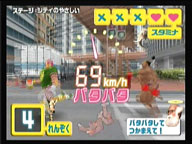
|
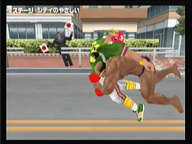
|
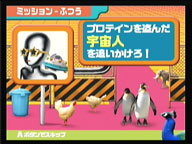
|
| Probable Rating | G |
| Release Date | 26/05/2009 |
| # of Players | 1-4 (Local) |
| Availability | Wiiware: JP Only |
| Language | Japanese |
| Fluency/Literacy Level | Basic: Hiragana/Katakana |
Games centering around bodybuilders aren't anything new, especially when you consider the Cho Aniki series. But unlike Cho Aniki, Muscle March isn't a surreal adventure in homoeroticism. Not that there's anything wrong with that. What it is though is steroid-filled game of keep-away kept simple.
The story goes as follows: You and your bodybuilding friends of all colours and creeds, as well as a polar bear, are all working out and having fun when you discover that someone has stolen your favourite protein supplement! It's up to you and your friends to chase the thief down and recover the protein supplement.
You start the chase at the end of the train made of biceps in hot pursuit of the thief. As the thief crashes through walls you must match the pose they make using the Wiimote and Nunchuk or take damage. The chase gradually speeds up and all the other bodybuilders fall victim to banana peels, leaving only you to take down your opponent. Eventually you get to the open road and have to sprint using the Wiimote/Nunchuk, once you've gotten fast enough you tackle your opponent to the ground. But just after your friends have added to the man-pile on top of the thief, the thief passes the protein to another thief and the chase is back on!
The gameplay follows the old-school method of adding extreme difficulty to simplicity. While during the chase there are only four muscle-clenching poses you can do, you sometimes have less than a second to be able to pull it off when you get to the insane sped-up sections just before the tackle. This is also compounded by the delay between certain poses where the character goes through another pose to get to the one you wanted. Though sometimes just flailing the controls randomly is sufficient to pass through a wall...
While the gameplay can be repetitive, the level designs are just bursting with background details. Almost everything occurring in the background is humourous or interesting. I found myself being distracted by it a lot and not looking at what pose was coming up.
The music used is a sort of sped-up dance-pop assortment that fits in well with the hectic nature of the game. Very reminiscent of the kind of music used in Katamari.
I think multiplayer is a bit of an afterthought in this game. It basically consists of the old fashioned pass-the-controller-around method where players compete against each other in a sort of survival mode.
Overall I find the game quite enjoyable even with it's flaws, though the 800 point price tag does feel like a bit of a let down. You don't really need much knowledge of Japanese to play it, there's no dialogue options to pick and almost all the modes have large pictures accompanying them that explain what to do.
See you space cowboy next muscle
Next week Mutsuki will be taking the ball and rolling it up - we'll take at the titles from the past, as well as have a look at the most current one which came out just recently. We'll also have a look at other PS2 games that hit the shelves.
Are you good with words? How about naming things? Think you can come up with a name for this column?
If so, send your submission to [email protected] (jon at animenewsnetwork.com.au?subject=Name%20the%20Column%20Competition) and you could win fabulous prizes if you win! Up for grabs your choice of either two games mentioned in our first ever column or one game mentioned in any subsequent column until the competition's closing date of 11:59PM Australian EST 31 October 2009. Downloadable games will be either gifted or substituted for an equivalent amount of points/gift cards.